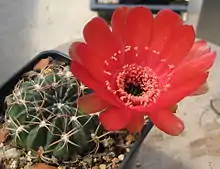| Lobivia calorubra | |
|---|---|
 | |
| Scientific classification | |
| Kingdom: | Plantae |
| Clade: | Tracheophytes |
| Clade: | Angiosperms |
| Clade: | Eudicots |
| Order: | Caryophyllales |
| Family: | Cactaceae |
| Subfamily: | Cactoideae |
| Genus: | Lobivia |
| Species: | L. calorubra |
| Binomial name | |
| Lobivia calorubra (Cárdenas) Rausch | |
| Synonyms | |
| |
Lobivia calorubra is a species of Lobivia found in Bolivia.[1]
Description
Lobivia calorubra is a type of cactus with stems that can reach heights of 6-7 feet and widths of 14 cm. These stems have 16 ribs and areoles, each bearing a single central spine that can grow up to 2.5 cm long, as well as 9-13 slightly curved radial spines. The flowers of this species are noteworthy for their orange-red upper parts and bluish-pink bases, reaching sizes of up to 15 cm.[2]
Distribution
This species is distributed in the departments of Santa Cruz, Tarija, and Cochabamba. It is found at elevations ranging from 2,400 to 3,000 meters and in grassland environments.[3][2]
References
- ↑ "Lobivia calorubra (Cárdenas) Rausch". Plants of the World Online. Retrieved 2023-12-21.
- 1 2 "Lobivia calorubra". llifle.com. 2013-08-04. Retrieved 2023-12-21.
- ↑ "On-line Guide to the positive identification of Members of the Cactus Family". On-line Guide to the positive identification of Members of the Cactus Family. Retrieved 2023-12-21.
External links
 Media related to Lobivia calorubra at Wikimedia Commons
Media related to Lobivia calorubra at Wikimedia Commons Data related to Lobivia calorubra at Wikispecies
Data related to Lobivia calorubra at Wikispecies
This article is issued from Wikipedia. The text is licensed under Creative Commons - Attribution - Sharealike. Additional terms may apply for the media files.